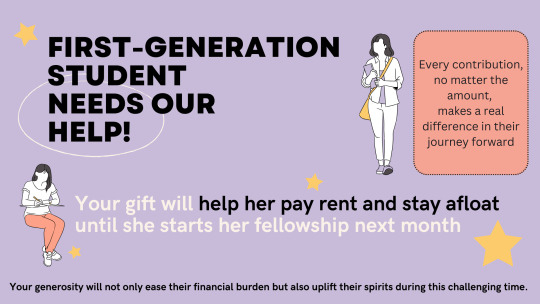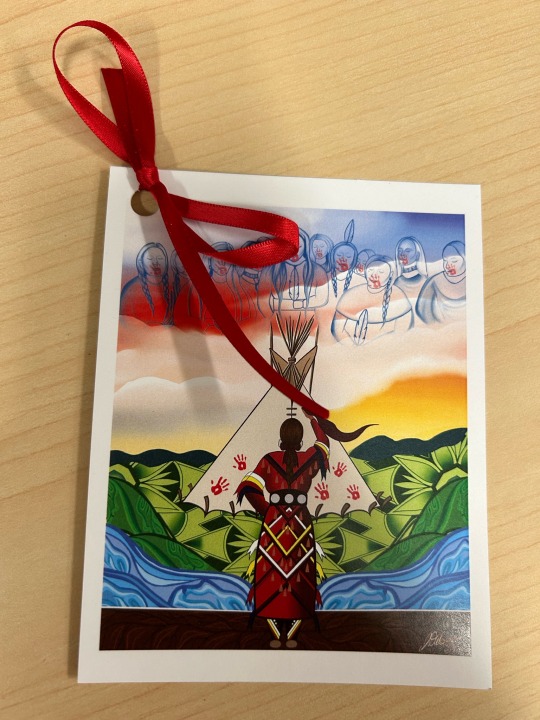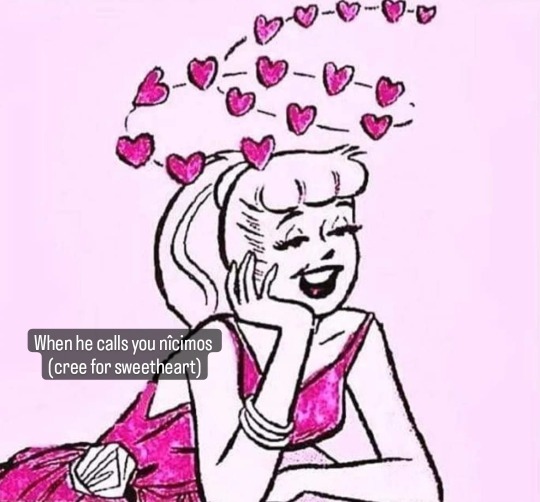#indigenous resilience
Explore tagged Tumblr posts
Text

Community, we need your help!
Due to health complications, this first-generation student is in need of a little extra support to stay afloat until they start their new job next month.
We're aiming to raise $1600 ASAP to cover past-due rent and an additional $2000 for this month's rent and bills. Every single contribution, big or small, makes a real difference in their journey forward.
Let's show them the power of community support! Your generosity will not only ease their financial burden but also uplift their spirits during this challenging time.
Donations can be made via this givebutter fundraiser. Or, you can reach out to me directly to donate via paypal or venmo to avoid transaction fees.
Thank you!!!
#mutual aid#fundraiser#first generation#indigenous#rent relief#signal boost#givebutter#resilience#medical debt#indigenous resilience
3 notes
·
View notes
Text
People who give more than they get. Mothers who love their children, fathers who stay. Grandparents who babysit, even in a wheelchair. We create beauty out of scraps. Hold cars together with duct tape. Work jobs and sell beadwork for cash to 'have a little extra.' Make frybread even though we know it isn't good for the diabetes but because it's good for the spirit. Resilience is making decisions that benefit the whole instead of just the individual. It's getting up and putting one foot in front of the other, even when you don't want to. This is our resilience.
Marcie Rendon, Resilience
#Marcie Rendon#Resilience#Living Nations Living Words#love#love quotes#family#community#beadwork#frybread#Indigenous Peoples Day#Indigenous literature#poetry#poetry quotes#quotes#quotes blog#literary quotes#literature quotes#literature#book quotes#books#words#text
81 notes
·
View notes
Text
In response to last year’s record-breaking heat due to El Niño and impacts from climate change, Indigenous Zenù farmers in Colombia are trying to revive the cultivation of traditional climate-resilient seeds and agroecology systems.
One traditional farming system combines farming with fishing: locals fish during the rainy season when water levels are high, and farm during the dry season on the fertile soils left by the receding water.
Locals and ecologists say conflicts over land with surrounding plantation owners, cattle ranchers and mines are also worsening the impacts of the climate crisis.
To protect their land, the Zenù reserve, which is today surrounded by monoculture plantations, was in 2005 declared the first Colombian territory free from GMOs.
#good news#science#environmentalism#indigenous people#indigenous agriculture#zenù#agroecology#nature#environment#farming#sustainable farming#climate resilience#climate change#columbia
56 notes
·
View notes
Text
Dance as a form of resistance shared by indigenous peoples. I love this mashup ✊🏽
I love this young man, I love his defiant war dance, I love his fearlessness, dancing in his protective kuffiya and Palestine around his waist, with his slingshot against occupation military fire and snipers.
Palestinians knows love and stand courageously for the love of life. Nothing could break it or their power to stand tall in the face of injustice.
This is from the peaceful Great March of Return 2018 by civil society. When Israel occupation forces surrounded peaceful protesters in Gaza, opened fire and massacred at least 150 Palestinians.
#gaza#free palestine#free gaza#first nations#palestinians#native american#culturalheritage#dance#dancers#colonization#occupation#freedom#we are all one#people power#resistance#stop the genocide#resilience#genocide#free people#palestinian lives matter#native american lives matter#fight for justice#fight for my way#fight for freedom#palestine will be free#indigenous people
124 notes
·
View notes
Text


How am I to tell stories about life — Without becoming the eccentric Sámi Making jokes at my own expense — How I am to explain to them that the ruin is in my voice
Ædnan by Linnea Axelsson, trans. Saskia Vogel / Portrait of a young woman. The artist's sister Anna Hammershøi by Vilhelm Hammershoi (1885) / The Tempest by Peder Balke (1862)
#Aednan#Linnea Axelsson#litedit#bookedit#digital collage#my edit#picked this up out of curiousity. got hit in the face with indigenous pain and resilience and three generations of displacement and#forced assimilation and family.#and also language loss. as soon as it got into language loss and the attempts to relearn the language you should have grown up with....#i had to lie down#hey. go read this epic. its a novel in verse by a northern sami author
18 notes
·
View notes
Text

Indigenous , b*tch. Proud of it.
#indigenous#two spirit#landback#photography#digital art#courage#lgbtia+#resilient#good vibes#unity#strength#instagay#2 spirit
116 notes
·
View notes
Text
Red Dress Day: Honouring Memories and Raising Awareness for Missing and Murdered Indigenous Women, Girls, and Two-Spirit People
May 6, 2024
Shaina Tranquilino

In Canada, Red Dress Day serves as a poignant reminder of the ongoing crisis surrounding missing and murdered Indigenous women, girls, and two-spirit people (MMIWG2S). This solemn occasion, marked by the hanging of red dresses in public spaces, symbolizes the lives lost and the urgent need for justice and systemic change. As we commemorate Red Dress Day, it's crucial to reflect on the profound impact of this crisis and renew our commitment to advocating for the rights and safety of Indigenous communities across the country.
The Significance of the Red Dress:
The red dress has become a powerful symbol in the movement to raise awareness about MMIWG2S. It represents the women, girls, and two-spirit individuals who have gone missing or been murdered, their spirits, and the bloodshed that continues to stain the fabric of Indigenous communities. Each red dress hung serves as a silent tribute, a visual reminder of lives cut short and families torn apart by violence and injustice.
Honouring the Memories:
Red Dress Day is a time for reflection and remembrance. It's an opportunity for communities to come together to honour the memories of those who are no longer with us. Through ceremonies, gatherings, and art installations, Indigenous and non-Indigenous people alike pay tribute to the lives lost and reaffirm their commitment to seeking justice and accountability. It's a solemn occasion but also a chance to celebrate the resilience and strength of Indigenous communities in the face of adversity.
Raising Awareness and Demanding Action:
Beyond remembrance, Red Dress Day serves as a call to action. It's a reminder that the crisis of missing and murdered Indigenous women, girls, and two-spirit people is not a thing of the past but a present-day reality. Indigenous women are disproportionately affected by violence and are more likely to experience homicide or disappearance compared to non-Indigenous women. This alarming statistic underscores the urgent need for systemic change to address the root causes of this crisis, including colonialism, systemic racism, poverty, and inadequate access to resources and support services.
Advocates and activists use Red Dress Day as an opportunity to raise awareness about MMIWG2S and to demand action from governments, law enforcement agencies, and society at large. They call for improved support services for victims and their families, culturally sensitive policing practices, and meaningful efforts to address the underlying factors that contribute to violence against Indigenous women and girls. By amplifying their voices and advocating for change, they strive to ensure that the lives lost are not forgotten and that future generations can live free from fear and harm.
Red Dress Day is a solemn yet empowering occasion that reminds us of the ongoing crisis of missing and murdered Indigenous women, girls, and two-spirit people in Canada. As we honour the memories of those who are no longer with us, we must also recommit ourselves to the fight for justice, equality, and respect for Indigenous rights. By standing in solidarity with Indigenous communities and demanding action from our leaders, we can work towards a future where every woman, girl, and two-spirit person is safe, valued, and able to live their lives free from violence and discrimination.
#red dress day#MMIWG2S#honouring memories#lost lives#stolen lives#Indigenous rights#justice for MMIWG2S#end violence#solidarity#awareness#demand action#equality#justice for Indigenous women#remembering our sisters#resilience#Indigenous strong#end violence now#support Indigenous communities
29 notes
·
View notes
Text
https://ictnews.org/news/a-place-for-acceptance

#!!!#indigenous#two spirit#native american#good news#ndn#resilience#transgender#lgbtq#queer#rapid city#south dakota
23 notes
·
View notes
Text
Nurturing the Heart: Understanding the Social and Emotional Well-being of Aboriginal and Torres Strait Islander Communities
Welcome to my Blog series on PSYCHOLOGY, WELL-BEING, AND RESILIENCE Where I will highlight 5 interesting topics. Read to explore!
In the rich tapestry of Aboriginal and Torres Strait Islander cultures, the essence of well-being lies in the social and emotional interconnectedness. As highlighted by the Commonwealth of Australia in 2017, this delicate balance serves as the cornerstone upon which both physical and mental health are built.
It's important to recognize that the concept of social and emotional well-being transcends individual experiences, encompassing a web of relationships that extend from the individual to the family and community. As noted by Brown et al. (2023), the nuances of well-being vary across Indigenous communities, shaped by diverse cultural perspectives and historical contexts. The notion of social and emotional well-being acknowledges that a person's well-being is also impacted by the social determinants of health. Indigenous Australians define health as the "social, emotional, and cultural well-being of the whole community" in addition to an individual's physical well-being (Fatima et al., 2023, p.31). This definition is based on a person's relationships to their country, culture, family, spirit, and physical and mental health.
Additionally, the National Agreement acknowledges that Aboriginal and Torres Strait Islander cultures are essential to better life outcomes for Indigenous Australians. All initiatives carried out by the Agreement must uphold, protect, and enhance these cultures. The following goals have been specifically set by the agreement to promote the cultural wellness of Indigenous Australians as shown in Figure 1 below (indigenoushpf.gov.au, 2024).

Figure 1: Targets to support cultural well-being
(Source: indigenoushpf.gov.au, 2024)
This particular group is marked with suicides and attempts to death based on different stress in life and stress factors. In the words of Smallwood et al., (2023, p.2088), the Aboriginals and Torres Strait Islanders had been facing severe issues over time in search of good living and livelihood. Owing to this there had been intervention which was developed for the betterment of indigenous people living in Australia. Figure 2 below shows the rate of suicide attempts which had been caused by the people of this indigenous group (indigenoushpf.gov.au, 2024). Thus, the intervention of the Mental Health Agreement was formulated to secure sustainability and improve the services provided by the Australian mental health and suicide prevention system. It also aimed to improve the mental health of all Australians and governments have come together to establish the Mental Health Agreement (Masotti et al., 2023, p.741).

Figure 2: Suicide attempts by Aboriginals
(Source: indigenoushpf.gov.au, 2024)
In addition to responding to the Productivity Commission Inquiry into Mental Health, the National Suicide Prevention Adviser's Final Advice, the Mental Health Agreement pledges to carry out work under the Fifth Plan going forward (indigenoushpf.gov.au, 2024). Regional planning and commissioning, priority populations, stigma reduction, safety and quality, gaps in the system of care and suicide prevention are the main areas of attention. On the other hand, psycho-social supports outside the National Disability Insurance Scheme (NDIS), workforce, and national consistency for initial assessment and referral are among the priority areas covered by the Mental Health Agreement.
References
Brown, A., Haregu, T., Gee, G., Mensah, F., Waters, L., Brown, S. J., ... & Armstrong, G. (2023). Social and emotional well-being of Aboriginal and Torres Strait Islander peoples in Aboriginal-controlled social housing. BMC public health, 23(1), 1935. https://link.springer.com/article/10.1186/s12889-023-16817-y
Fatima, Y., Liu, Y., Cleary, A., Dean, J., Smith, V., King, S., & Solomon, S. (2023). Connecting the health of country with the health of people: application of" caring for country" in improving the social and emotional well-being of Indigenous people in Australia and New Zealand. The Lancet Regional Health–Western Pacific, 31. https://www.thelancet.com/journals/lanwpc/article/PIIS2666-6065(22)00263-2/fulltext
indigenoushpf.gov.au (2024) Social and emotional wellbeing Retrived on 9 May 2024 from: https://www.indigenoushpf.gov.au/measures/1-18-social-emotional-wellbeing
Masotti, P., Dennem, J., Bañuelos, K., Seneca, C., Valerio-Leonce, G., Inong, C. T., & King, J. (2023). The Culture is Prevention Project: measuring cultural connectedness and providing evidence that culture is a social determinant of health for Native Americans. BMC Public Health, 23(1), 741. https://link.springer.com/article/10.1186/s12889-023-15587-x
Smallwood, R., Usher, K., Woods, C., Sampson, N., & Jackson, D. (2023). De‐problematising Aboriginal young peoples’ health and well‐being through their voice: An Indigenous scoping review. Journal of clinical nursing, 32(9-10), 2086-2101. https://onlinelibrary.wiley.com/doi/pdf/10.1111/jocn.16308
#psychology#wellbeing and resilience#aboriginal australian#indigenous issues#first nations#indigenous rights#indigenous health and wellbeing
7 notes
·
View notes
Text
In an era where the effects of climate change are being felt globally, Tanzania's agricultural sector is undergoing a remarkable transformation. Agriculture remains the backbone of the country’s economy, and as weather patterns become increasingly unpredictable, farmers are facing unprecedented challenges, from droughts to floods and new pest outbreaks. However, thanks to innovative, science-based approaches, Tanzania is becoming a leader in building climate resilience, enhancing food security, and promoting sustainable agriculture.
#solarpunk#solar punk#indigenous knowledge#africa#jua kali solarpunk#informal economy#resilience#climate change#transformation#sustainable farming#farmers#agriculture#tanzania
5 notes
·
View notes
Text
youtube
This is the clearest and most beautiful video of an Apache Sunrise Dance. This is on my Rez and it looks like they got permission to record the Ceremony. The narrator explains what is going on in the video. The songs are in apache and the drums are water drums. I guess I wanted to share this video with others who are not my family, they go to help out at these dances and it is long and hard. The comments are turned off but you can leave a comment or ask general questions here. thx
#indigenous peoples#indigenous sovereignty#indigenous rights#indigenous solidarity#decolonialism#decolonization#first nations#native american#turtle island#white mountain apache#youtube video#dance#ceremony#music#women#womanhood#resilience#apache#Youtube#ndn#girlhood#usa#indigenous music
12 notes
·
View notes
Text
-
#@anon#You know one of the things that people tend to do but absolutely not in favour of Palestinian resistance and liberation movement is#the condemnation of resilients and freedom fighters#it is really not the pro Palestinian stance#The liberation movement is not a peaceful one#ask the million martyred Algerian to liberated their land from french occupation#The people of Palestine are able to rise against their oppressor and are able to organise and to lead their liberation movement and have#their freedom fighters#USA or any western nation categorizing these resistance mouvements as terrorist its well their own racist shit#In the words of Refaat Alareer may he rest in power:#“Saying Hamas is a tool of Israel is saying the Vietnam fighters were a tool of America The Warsaw ghetto rebels a tool of the Nazis”#Black freedom fighters a tool of the slave owners And the indigenous peoples of America a tool of the European colonisers etc etc#and he was so right#Palestine#gaza#genocide
12 notes
·
View notes
Text

credit - unknown
#indigenous#anishinaabe#métis#mixed#native#indigenous heritage#anishinaabemowin#ndn#indigenous art#indigenous stories#resilience#indigenous resistance#two spirit
9 notes
·
View notes
Text
youtube
Genocide doesn’t just happen out of the blue. It gradually builds up over time. The destruction of a people’s culture, lifestyle, communities, landmarks, corrupting their relationship with the land, that how genocide works. That what the massacre of indigenous peoples does, it destroys the land and poisons history.
#free palestine#palestine#free gaza#save gaza#palestinian liberation#signal boost#social justice#stop apartheid in palestine#save the people of gaza#adding tags to your posts helps people find them#social matters#things you should care about#things that make me mad#things that keep me up at night#genocide in gaza#gaza genocide#from river to sea palestine will be free#justice for palestine#palestinian resilience#indigenous people#history#tumblr fypage#silence is violence#neutrality is violent#end settler colonialism#settler violence#Youtube
9 notes
·
View notes
Text

Lee Maracle, I am Woman (1988)
#u guyssss this book is so good istg#anyway as we're moving more away from gomens i'm probably going to post more quotes i find n stuff lol#lee maracle#indigenous feminism#decolonization#on resilience#on resistance#on being unkillable#poetry#words n quotes#words words words
6 notes
·
View notes
Text



Indigenous love master post
Because indigenous women are hella resilent, dealing with colonial bullshit, racism, misogyny, and men who need healing
We are deserving of healthy love too
#nîcimos#sweetheart#hehehe#indigenous love#indigenous sensuality#intersectional#love#indigenous#personal#its a me#art#sensuality#native women#native humor#selfie#resilient#indian love poems#native love#you are worthy#cree#feminism#intergenerational trauma#intergenerational healing
17 notes
·
View notes